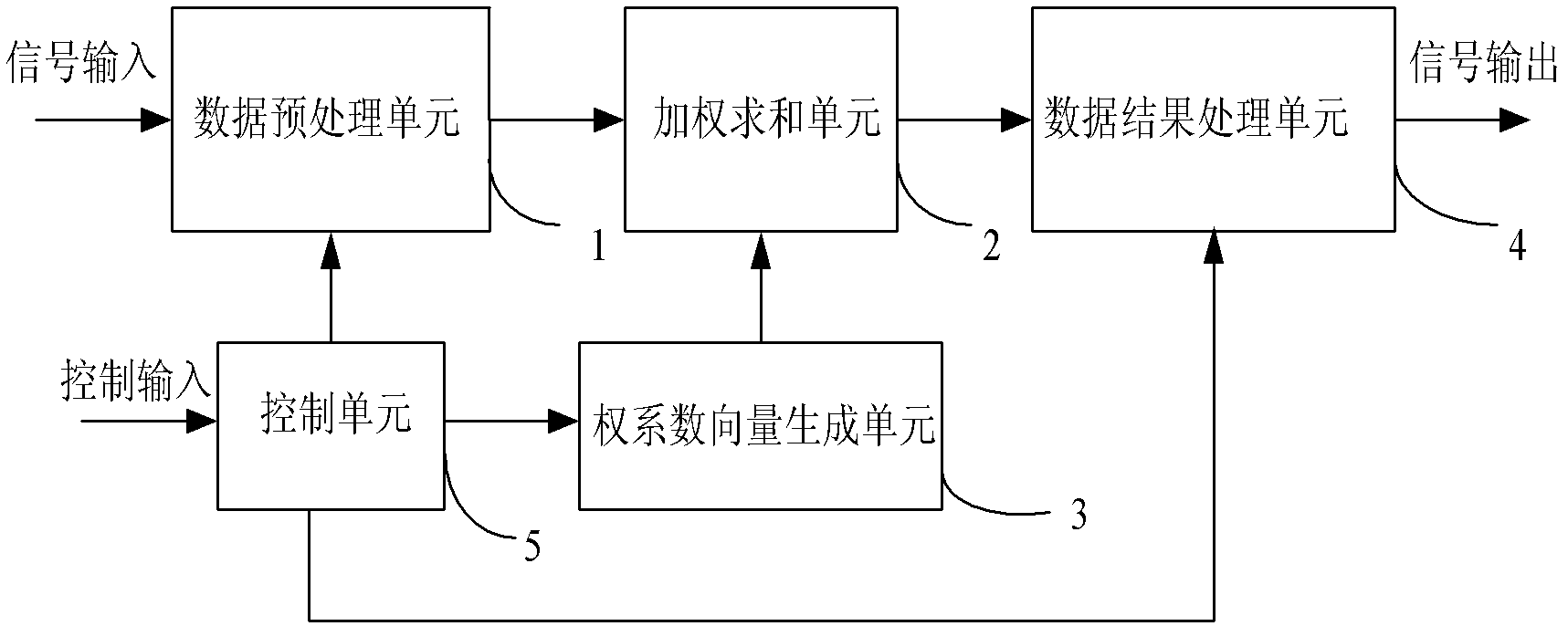Field programmable gate array (FPGA)-based general wave beam forming device
A beam and generation unit technology, applied in the field of general structures, can solve problems such as weak versatility and singleness, and achieve the effects of improving signal processing capability, flexible control, and cost saving
- Summary
- Abstract
- Description
- Claims
- Application Information
AI Technical Summary
Problems solved by technology
Method used
Image
Examples
Embodiment 1
[0036] In this example, an FPGA-based general-purpose beamforming device is used to form a narrowband beamformer. The basic principle of narrowband beamforming is: the signals received by M array elements are used as the input of the M-order spatial filter, and the filter weight vector can be expressed as w=[w 1 w 2 L w M ] T , the plane wave s(n) with an angle of q is incident on the array, regardless of the influence of the receiver noise, at this time the received signal of the array is x(n)=a(q)s(n), where a(q) is any Array flow type. Then the output of the filter is y(n)=w H x(n)=w H a(q)s(n), by changing the weight vector w of the filter, the amplitude of the output signal can be changed or the signals in some directions can be passed, while the signals in other directions can be suppressed.
[0037] In narrowband mode of operation, the beamformer such as image 3 shown.
[0038]The functions of each functional unit are described as follows:
[0039] In the da...
Embodiment 2
[0050] In this example, an FPGA-based general-purpose beamforming device is used to form a broadband beamformer. The basic principle of broadband beamforming: M array elements are decomposed into several sub-frequency bands through discrete Fourier transform in the frequency domain, then beamforming is performed in each sub-frequency band, and finally the output signal is obtained through inverse discrete Fourier transform. The array output data vector x(n) is decomposed into J non-overlapping narrowband parts through DFT. f j The data vector obtained on the frequency band is X(j), and the weighted summation of X(j) and W(j) can obtain the beamforming result on each frequency band, and the results obtained by processing all sub-bands can be obtained by IDFT on the entire frequency band overall result.
[0051] In wideband mode of operation, the beamformer such as Figure 4 shown.
[0052] The functions of each functional unit are described as follows:
[0053] In the data...
Embodiment 3
[0064] In this example, an FPGA-based general-purpose beamforming device is used to form a multi-beamformer. The basic principle of multi-beamforming: After processing the data of M array elements, there will be output results in different directions. The input data vector x(n) is weighted and summed with N groups of different weight vectors w, and N groups of results can be obtained. are the data of the input signal after spatial filtering in N different directions, respectively.
[0065] In the multi-beam working mode, the beamformer structure is as follows Figure 5 shown.
[0066] The functions of each functional unit are described as follows:
[0067] In the data preprocessing unit 1, the control unit connects the FIFO buffer 11 through the multiplexer 10, bypasses the DFT operator 12, and the input signal can pass through the FIFO data buffer, and the depth of the FIFO buffer is set to L. The input data sequence is divided into data blocks with length L, and each data...
PUM
 Login to View More
Login to View More Abstract
Description
Claims
Application Information
 Login to View More
Login to View More - R&D
- Intellectual Property
- Life Sciences
- Materials
- Tech Scout
- Unparalleled Data Quality
- Higher Quality Content
- 60% Fewer Hallucinations
Browse by: Latest US Patents, China's latest patents, Technical Efficacy Thesaurus, Application Domain, Technology Topic, Popular Technical Reports.
© 2025 PatSnap. All rights reserved.Legal|Privacy policy|Modern Slavery Act Transparency Statement|Sitemap|About US| Contact US: help@patsnap.com



